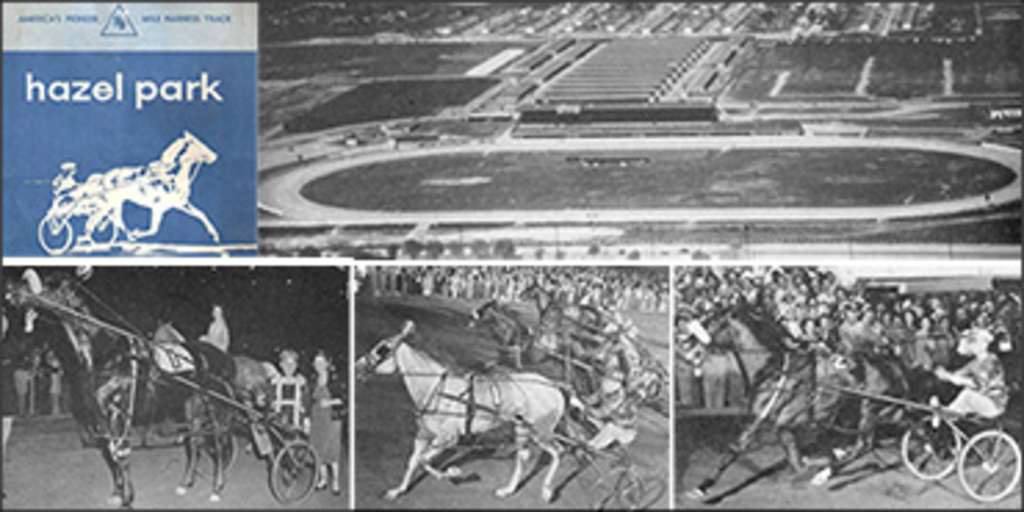
 In this week's Rewind Robert Smith recalls the start-up of Hazel Park Raceway, the first ever five-eighths mile track used for harness racing.
In this week's Rewind Robert Smith recalls the start-up of Hazel Park Raceway, the first ever five-eighths mile track used for harness racing.

Shown above is an old Hazel Park program bearing the words "America's Pioneer 5/8 Mile Track"
Its opening in 1953 ushered in the first of two new racing facilities to debut that year that introduced tracks that were not the traditional half-mile size. The second, which was Vernon Downs, will be profiled in a future Rewind.
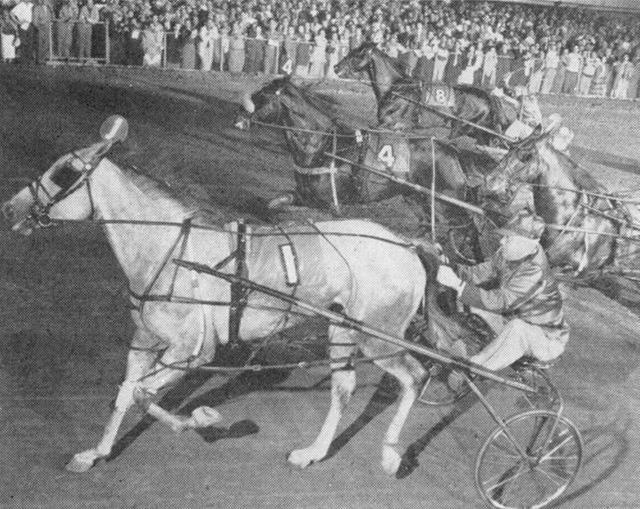
One of the fastest miles turned in on the new five-eighths mile track at Hazel Park's inaugural meeting in 1953 belonged to the grey mare Ginnie Lee C. She was driven to her lifetime best by Floyd Milton for owner George W. Sherman of Rodney, Ont. Time for the speedy mile was 2:03.2, considered quite a fast trip in those days [Harness Horse]
About 63 years ago a rather subtle but very significant change took place in the history of Harness Racing as a whole. The year 1953 marked the introduction of the five-eighths mile track for trotters and pacers. This then new and revolutionary sized track was introduced at Hazel Park Raceway, located in Hazel Park, Michigan, a suburban locality just north of the city of Detroit. Henceforth Hazel Park has carried the designation "America's Pioneer Track." While the use of the new-sized track was a first for the harness breed, the Hazel Park course had been around for some time and had hosted Thoroughbred racing dating back to 1949. Located on a former landfill, the site was originally destined for auto racing but those plans did not materialize.
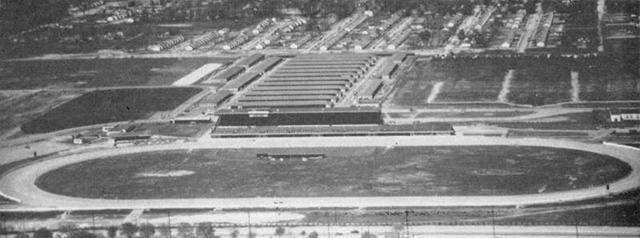
An aerial view of the newly-opened Hazel Park Raceway featuring the sport's first five-eighths mile oval. [Harness Horse]
Apart from certain famous mile tracks such as The Red Mile and similar sized ovals at Indianapolis and Inglewood, harness racing was traditionally conducted over a half-mile track. Throughout both Canada and the United States, at one time dating back to the 1800's, virtually every locality in the land could boast of a half-mile track at the Town's fairgrounds. Some were slightly shorter or longer, but were all basically the regulation half-mile. This was the start of a new trend; nine years later Canada would get its first 'new-sized' racing strip.
Harness racing fans have always loved a half-mile track; the reasons are pretty simple. With the start of the race taking place right in front of the grandstand, they are afforded a "bird's eye" view of one of the race's first elements. Also fans are provided with three "looks" -- the start, the half-mile station and the finish. While this distance provides the fan what they like, it has not always been the best for the on-track participants.
The main value of the five-eighths mile track was to allow the horses to start midway between turns, thus being able to gather and hold their speed prior to encountering the first turn. Also with a larger-sized oval, the turns are just automatically less sharp. Another major benefit believed to be a positive factor in the new sized track was also safety. For those in charge of record keeping, it opened another entire new section in the official 'book'.
An excerpt from a write up in the Harness Horse magazine summed up the new-sized racing strip in the following way. "The wide turns and long stretches have met with the approval of the horsemen and the meeting has attracted an unusually high quality of racing stock. All races on opening night were at the one-mile distance, the horses starting on the backstretch at the quarter pole which makes a long straightaway before reaching the upper turn."
On the evening of May 7, 1953 an eight-race card signalled the advent of harness racing over a five-eighths mile track as Hazel Park welcomed five pacing events and three on the Trot. A huge crowd in excess of 10,000 set a Michigan opening night wagering record of $325,149. Seven races were single-heat affairs with the featured Trot going in the old two-heat format. The winner of the very first race was a horse named Calumet Wayne driven by Jimmy Wingfield, a fairly young trainer in his first year of operating his own stable. This was the man who groomed the great Greyhound throughout his racing career.
If observers were looking for an immediate "spike" in speed tabs, they would have to wait. The opening night weather brought showers all day and throughout the races and thus a "heavy" track which required a lot of sand being added. The quickest mile on debut night was a dismal 2:13.4 in the feature called "The Ville de Troit" Trot for a purse of $5,000 won by Scotch Harbor. However, by the second night, the weather had settled and the first clocking in sub 2:10 territory saw a mile in 2:06.3 recorded by True Spencer handled by the meeting's leading driver Wayne Smart. The announcer who called this historic meeting was the legendary Stan Bergstein.
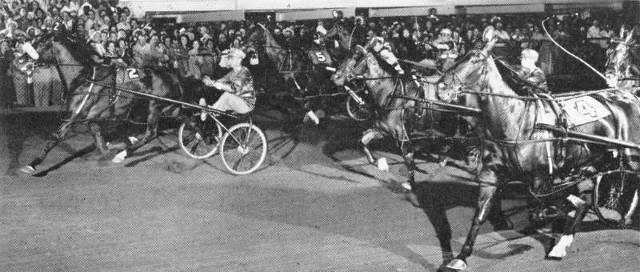
Mr. Oakley (2) glides to the wire a winner for driver Harold Wellwood and owner Wesley Litt of Stratford, Ont. At age seven this horse took a lifetime mark of 2:05.1 at the new Hazel Park track. [Harness Horse]
A small number of Canadian-based stables were among the inaugural gathering; most were just beginning the 1953 racing season. The very first Canadian horse to hit the winner's circle from the H.P. five-eighths oval was from just across the border. Axland Jr. owned by twin brothers Bruce and Bryce Fulmer of Windsor, Ont. was a victor for driver Howard Hampton. The winning time was 2:13 and occurred on just the third evening of racing.
Members of the family of Bruce Fulmer are still active in the sport with son Randy a longtime driver and now a trainer, as well as his sister Jan Adams who has worked for many years with the top stable of Bob McIntosh. Just recently a member of the next generation was honoured at the 2015 O'Brien awards when Ron Adams received the Future Star Award.
Among the most successful Canadian stables was that of Harold Wellwood, who after missing the early portion of the meeting ended up as the second winningest driver with a total of 12 victories. Other Canadian teamsters included Floyd Milton, Bob Givens, George Sherman, Lindley Fraser and Ralph Baldwin who while Canadian-born had been on the U.S. side for many years by this time. A couple of very accomplished female drivers, Lucille Fleming and June Dillman scored victories during the six-week meeting.
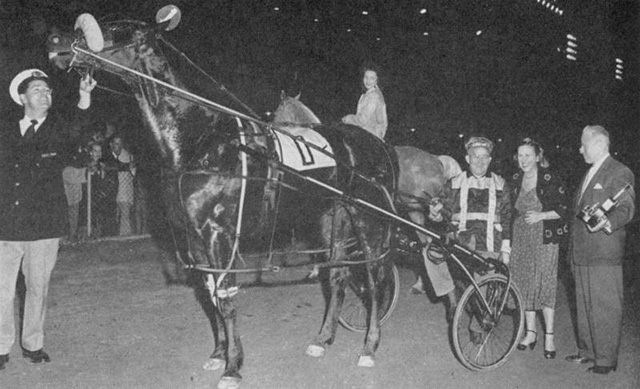
Above photo shows the winner's circle gathering following Hazel Park's First Edition of "The Detroit Pacing Derby" for a purse of $10,000. The winner was H B Chief owned by Castleton Farm of Lexington, Ky. Mrs. Frederick Van Lennep accepts the trophy from Raceway V.P Jack Tompkins while a smiling driver Wayne "Curly" Smart looks on. [Harness Horse]
A large and very powerful stable of performers belonging to The Castleton Farm of Lexington, Ky. completely dominated the first Hazel Park meeting. Their stars were front and centre throughout the entire meeting and at times raced as entries with two or more horses in some stake races. Trained by the famed Ohio reinsman Wayne "Curly" Smart the Castleton horses quickly became fan favourites. Smart swept all driving categories winning a phenomenal 32 races to go along with two seconds and one third. In second place a distant second tied with 12 victories were Jimmy Wingfield and Harold Wellwood. Other top drivers included Jerry Neikirk, Joe Lighthill, Eddie Fox and Mac McQuarrie.
Famous Canadian Horse Dies on the Track
While the new venture at Hazel Park was a joyous six-week experience for most involved, it was unfortunately a sad day for racing fans across the land and especially in Canada. Near the end of the meeting the great Canadian-owned pacer Dr. Stanton dropped dead during a morning training session on the new Hazel Park track. He had made five starts during this meeting. The 12-year-old gelding had provided fans from coast to coast with many thrilling moments dating back to his debut in 1946. His accomplishments had elevated him to superstar status with career earnings of $172,000, making him the sport's richest performer at that time. He was owned throughout his career by Lindley Fraser of Forest, Ont. This great horse who was originally purchased for $500 as a "misfit" was transported back to his owner's property near Warwick, Ont. where he was buried. To this day he is still fondly remembered by many and is a member of The Canadian Horse Racing Hall of Fame.
Attendance And Handle - Hazel Park's Inaugural Meeting
Total attendance for 33 nights - 199,088
Total Wagering for 33 nights - $10,332,868
Average crowd - 6,033
Average handle - $313,144
Largest crowd - 11,102
Largest single night handle - $468,088
"Speed" Analysis of The First Season of 5/8 Mile Sized Track
Fastest Pacing Mile - True Spencer 2:02.1 (Wayne Smart)
Fastest Trotting Mile - Kashaplenty 2:03.4 (Wayne Smart)
Fastest 3 Y.O. Pacing mile - Iosola's Ensign 2:03.1 (Wayne Smart)
In later years Hazel Park became a very popular spot for neighbouring Canadian horsemen. Many noted trainers and drivers such as Greg Wright, John Campbell, Bob McIntosh, Fred and Shelly Goudreau, Lou Clark, Bill Gale, Richard Carroll, Ron Henderson and scores more raced there. Today some 63 years after it debuted as the first five-eighths mile track, it remains in business but has not hosted standardbreds for several years.


It was probably North
It was probably North Americas first 5/8 mile track. They was used in Europe since before 1920.